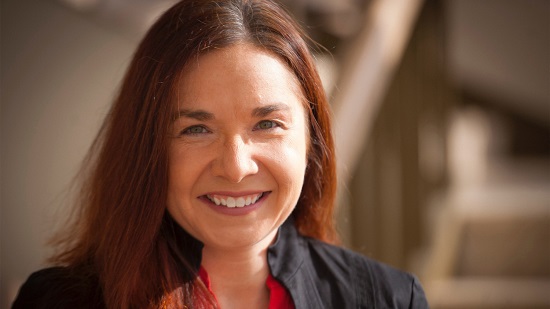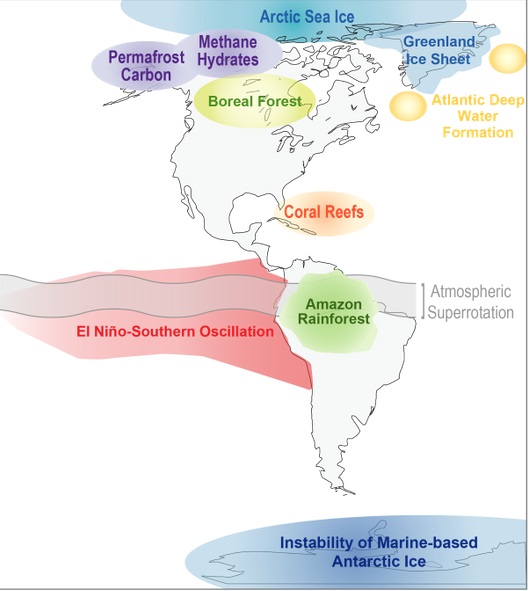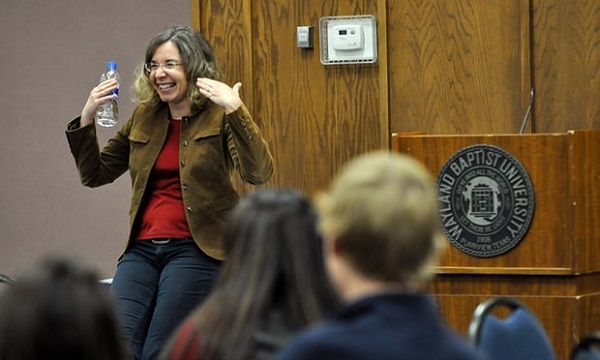Or it may be God with climate scientist on her side. Whichever, Katharine Hayhoe is one smart lady. A New Scientist interview (no doubt pay-walled) caught my interest.

There is a longer interview at Carbon Brief which rewards reading. She’s one of the most informed, balanced and insightful climate scientists I’ve come across.
How she got into climate science is worth relating.
She was doing a degree in astrophysics and had already done courses to round it out in Spanish, the Gothic cathedral and children’s literature:
- “… so when I was looking around for an extra course that might be interesting and I saw a class on climate modelling over in the geography department. I thought to myself, “Well, that’s probably interesting, but probably easy. Why don’t I just take it?”
As it turned out it was easy, just:
- a special case of planetary atmospheres, it depends on radiative transfer and nonlinear fluid dynamics
Then:
- the second thing I learned was that climate change is such an urgent problem – because up until that point I viewed climate change as one of a suite of important environmental problems: air pollution, water pollution, biodiversity loss, climate change. But I did not realise that climate change is, as the military now puts it, a “threat multiplier” that is exacerbating all of those other issues to the point where we are not going to be able to fix any of those other issues if we leave climate change out of the picture. Not only that, but climate change is exacerbating humanitarian issues, as well – hunger, poverty, lack of access to clean water – it’s exacerbating these, too.
She’s a devout evangelical Christian, so when you see bad stuff that is important and urgent, you fix it. So she thought that she would work on climate science modelling in graduate school, fix it, then go back to astrophysics.
A couple of decades later, she’s still fixing it, with no end in sight. Essentially there is no computer big enough to completely model climate.
So her main business is looking at other people’s climate models, helping to improve them, sometimes developing new ones. At the same time:
- I work with people on the ground who want this information to put into water management models, to put into crop yield models, to put into models of how humans respond to extreme heat conditions and what impact that would have on our health. It fascinates me because we’re actually putting this information to practical use to help real people, and that’s why I decided to study climate change.
Working to make a difference.
Her eminence in the field is reflected in the fact that she was lead author in the Climate Science Special Report which is Volume 1 of the Fourth National Climate Assessment (NCA4) which is
- an authoritative assessment of the science of climate change, with a focus on the United States. It represents the first of two volumes of the Fourth National Climate Assessment, mandated by the Global Change Research Act of 1990.
So, published in 2017, it is at least four years more up to date than the latest IPCC report. She is critical of the IPCC process, which she says was suitable as a process when it began in the early 1990s. Now it ensures that most of the time policy makers are using out of date information.
I have not myself had time to digest her report, but she is keenest on the last chapter Chapter 15: Potential Surprises: Compound Extremes and Tipping Elements which seeks to identify where the future may surprise us, the known unknowns, if you like.
First they look at the possibility of compound extreme events:
- Some areas are susceptible to multiple types of extreme events that can occur simultaneously. For example, certain regions are susceptible to both flooding from coastal storms and riverine flooding from snow melt, and a compound event would be the occurrence of both simultaneously. Compound events can also result from shared forcing factors, including natural cycles like the El Niño–Southern Oscillation (ENSO); large-scale circulation patterns, such as the ridge observed during the 2011–2017 California drought (e.g., Swain et al. 2016 ; see also Ch. 8: Droughts, Floods, and Wildfires); or relatively greater regional sensitivity to global change, as may occur in “hot spots” such as the western United States. Finally, compound events can result from mutually reinforcing cycles between individual events, such as the relationship between drought and heat, linked through soil moisture and evaporation, in water-limited areas.
The report identifies some possibilities, but there can be new compound events not yet revealed – the unknown unknowns.
In addition to compund extreme events, tipping points may emerge from:

On sea level rise they emphasise the long-term nature, the effect over millennia, but I’ll just cherry pick this:
Plausible physical modeling indicates that, under the higher RCP8.5 scenario, Antarctic ice could contribute 3.3 feet (1 m) or more to global mean sea level over the remainder of this century, with some authors arguing that rates of change could be even faster.
The RCP8.5 scenario, roughly speaking, represents business as usual. With the rate of increase of CO2 emissions itself increasing this may be where we are heading if we don’t mend our ways, which I’m sure we will. However, it may not be soon enough for a safe climate.
On the 1.5°C target, she says:
Can we meet the 1.5°C target? It is still technically possible, but if we continue on our current emission rates for more than a decade or so, we will not be able to meet 1.5°C without substantial deployment of technology to remove CO2 from the atmosphere.
On Trump, she says the effect has been to make others redouble their efforts, for example states and cities. Ironically, we may achieve more during the Trump presidency than we otherwise would have as a result of Trump’s actions.
On climate science, she says there is no 50-50 debate, as it tends to be presented in the USA:
- There’s plenty of debates – genuine debates – in the climate science field, but there is no legitimate debate over whether climate is changing and humans are responsible because, as the Climate Science Special Report says, there is no alternative explanation for the warming.
If you look at natural factors, every single natural factor either says there will be no change or we should actually be cooling right now. If we look at the sun, if we look at volcanoes, if we look at orbital forcing, and if we look at natural cycles, none of them can explain the warming. In fact, we should actually be getting cooler today.
What comes through to me is that if you want to deny that the climate is changing, or accept change but deny human causation, you have to believe that temperature measurements are being systematically ‘fixed’ and the scientists are either in a conscious dishonest conspiracy or a giant group think.
It’s hard to fit scientists like Katherine Hayhoe into that mould.
Hayhoe is an evangelical Christian who spent five years as a missionary kid in Columbia. She is continuing her evangelical work by trying to convince Christians about climate science and the need for action. She says:
- In the book of Genesis, God entrusts humans with responsibility over all living things on Earth. Throughout the New Testament, we are repeatedly reminded to love others as we have been loved by God, and to particularly care for those who are poor and already vulnerable. Today, climate change disproportionately harms those people.
Many Christians in the US are told they don’t need to worry about climate change. Political evangelicals, as I call them, cherry-pick verses from the Bible and use them out of context to craft an unchristian theology of indifference – even hostility – to climate change. They argue, for example, that the world will end anyways, so why not hasten the process?
In the book of Revelation, however, we are told that God will destroy those who destroy the Earth. And the apostle Paul wrote to those passively waiting for Jesus to return to remind them that, although we don’t know when the world will end, they had plenty of work to do in the meantime, to support their families and care for widows and orphans. When I speak at churches and Christian universities, these are the types of messages I try to underline.
She is attacked often quite viciously every day. “Every. Single. Day.”
Her response, when people talk about sun spots?
Firstly, she says, don’t you think I would have thought about that in the last 20 plus years of studying climate science?
-
But the Bible says “the fruit of the Spirit is love, joy, peace, forbearance, kindness, goodness, faithfulness, gentleness and self-control”, and I consciously practise those things. It enables me to say, “I understand where you’re coming from. If I were you, that is a question I would have, and it deserves a respectful answer.”
I want to share not just my head with people, but also my heart.
In a 2014 study, she says:
-
only 35 per cent of white evangelicals and 41 per cent of white Catholics were concerned about climate change. In comparison, 58 per cent of black Protestants and 73 per cent of Hispanic Catholics were concerned.
Elsewhere:
- a 2008 study found that just 44% of evangelicals believed global warming to be caused mostly by human activities, compared to 64% of nonevangelicals (Smith and Leiserowitz, 2013) while, a 2011 survey found that only 27% of white evangelicals believed there to be a scientific consensus on climate change, compared to 40% of the American public (Public Religion Research Institute, 2011).
However Katharine Hayhoe is having some success in convincing doubtful evangelicals about climate change.
She spends some time when addressing evangelicals examining the difference between faith and science and uses the ‘trusted source’ approach.
Seems to me she has the personality, the articulateness and the grasp of both detail and the broader issues to generate trust:

Meanwhile back at the farm the Coalsheviks have broken out of their paddock again.
Minister Matt Canavan has written to the heads of Japan Oil, Gas and Metals National Corporation and the director of the coal division of Japan’s Ministry of Economy, Trade and Industry inviting them to invest in building coal-fired power in Australia. Apparently the postal service is so lousy he had to send maverick Nationals MP George Christensen to deliver the letters personally, with the trip funded by coal interests.
I’m not sure big George C would help to convince anyone of anything.

Brian, your post says:
Two days ago, IEEFA released a new report about Marubeni’s coal commitments are creating ‘needless reputational and financial risk’. Co-author, Simon Nicholas, Energy Finance Analyst says:
It seems Canavan has his eyes/ears closed to compelling arguments against supporting coal, and exposing Australia’s reputation to ridicule.
As reported yesterday at RenewEconomy.com.au Spain’s concentrated solar power association, Protermosolar has published a report that models a plan to achieve 85 per cent renewable energy by 2030 using a combination of wind, solar PV, and concentrated solar power (CSP) technologies. The article includes:
Perhaps Canavan should be focusing on the cheaper renewables (ie. PHES, wind, solar-PV, and solar thermal with storage), instead of spruiking the more expensive new HELE coal technology?
Carbon Brief has a media analysis of the reporting of this year’s northern-hemisphere summer that has seen a succession of heatwaves take hold in Europe, Asia, North America and northern Africa.
I wonder how much longer it will take for the deniers (and ‘skeptics’) of human-induced climate change science to concede they got it wrong?
Dr Christine Shearer, a researcher and analyst for the US-based energy research group CoalSwarm, has a guest post published yesterday at Carbon Brief. The post begins with:
That seems in direct contradiction to Senator Canavan’s letter reportedly saying world demand for coal is growing, especially in Asia which is supplied by Australia.
It seems the appetite for new coal investments is quickly disappearing – the Coalsheviks haven’t wised up to it yet.
What a refreshing change.
Glad to see Katharine Hayhoe is right onto the political evangelicals – whom I equate with the Wahhabists in Islam and with the dishonourable knights and the robber barons of the unholy Crusades. These are the same fake Christians who commanded “strip-mining for Jesus” in the Reagan era and who are now unsure whether it is The Cross at which they worship or their collection of hand-artillery and semi (for the moment)- automatic assault rifles.
Of course they will hate her with a fury. They know too damned well that the Holy Bible urges them to responsible stewardship of God’s gifts, as she has rightly pointed out – and they know that there ain’t no tax-free profits in that.
Hayhoe makes the point that many Christians are particularly un-Christian in what they say to her and wish for her.
But they don’t do it to her face.
It shouldn’t be surprising that the Evangelicals are reluctant to accept ideas that are based on science.
The Evangelicals have had a history of conflict with science in areas such as evolution vs creationism. They may also be uncomfortable with a scientific method that can only disprove but never 100% prove. Most of us crave certainty to some extent. The difference between us and the Evangelicals may simply be about what “certainties” we use to keep us comfortable.
We also have problems with the way climate change has been accepted/rejected by different political parties.
It is funny how the Jesuits, who got off to a really bad start, (murderous intolerance, ruthlessly enforced group-think – and worse). Yet within a couple of centuries, they changed themselves so that they embraced the scientific method and all the glories and uncertainties and mysteries of God’s wonderful universe. They showed, to the discomfort of some atheists, that Science and Faith are not necessarily enemies but can indeed complement one another. So what gives with the American Evangelicals? Are they so arrogant as to reject knowledge of God’s magnificent universe ? Their behaviour, in recent years, suggests that they have abandoned God – despite all their public praying, Bible reading and hymn-singing – and, instead, are now worshippers of Mammon and praisers of the Almighty Dollar.